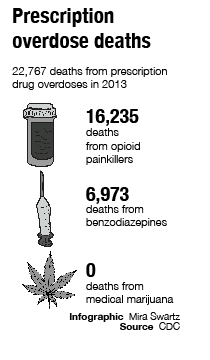Legalization of medical marijuana for pain overdue
January 18, 2016
Now that Minnesota will expand its medical marijuana legislation to allow patients suffering from chronic pain access to the drug, the rest of the country must do the same.
According to the Drug Enforcement Administration, marijuana belongs to the Schedule I category, which inhibits research on the drug. However, Surgeon General Vivek Murthy and the American Academy of Pediatrics both recently suggested marijuana needs more research in order to be better understood. This creates a contradictory situation in which medical marijuana cannot advance.
 According to Sanjay Gupta, CNN’s chief medical correspondent, roughly 94 percent of the 2000 studies on medical marijuana in recent years focused solely on the negative aspects of the drug.
According to Sanjay Gupta, CNN’s chief medical correspondent, roughly 94 percent of the 2000 studies on medical marijuana in recent years focused solely on the negative aspects of the drug.
Out of the research that does investigate the benefits of medical marijuana, many of the results demonstrate marijuana’s status as an effective form of medicine. In several studies, marijuana successfully treated symptoms of not only chronic pain but also cancer, multiple sclerosis and HIV/AIDS.
Marijuana certainly holds some negative properties. The NIDA associates marijuana with potential reduction of thinking and memory abilities, respiratory problems, depression and anxiety. NIDA also identifies marijuana as potentially addictive.
However, the medical community uses drugs with far worse side effects and much higher potential for addiction to treat patients’ symptoms.
Studies show the painkiller morphine has more addictive potential than marijuana, tobacco, alcohol and cocaine. In addition, morphine’s potential side effects include severe vomiting, problems with muscle control and abdominal pain, according to Mayo Clinic.
Some doctors continue to use drugs like morphine because they believe its benefits outweigh its risks. The medical community should apply the same mentality to medical marijuana.
For decades, critics have reinforced an unnecessary stigma while the government inhibits research on a proven-effective drug. All of this occurs at the cost of chronic pain suffering.



